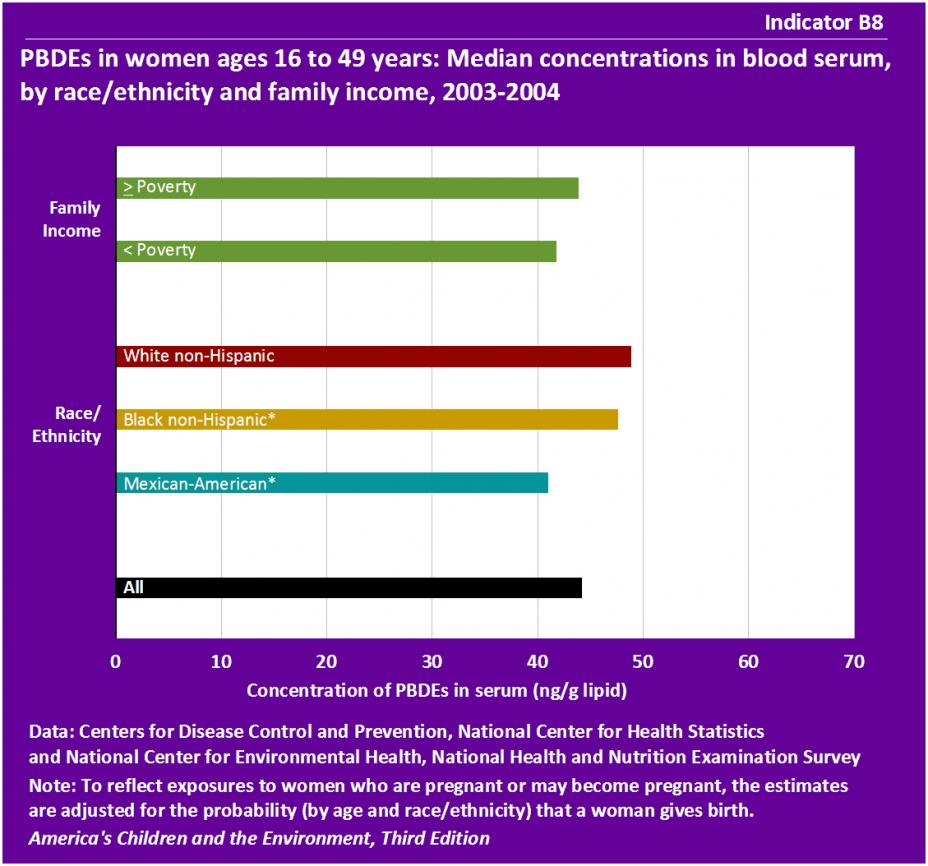ACE: Biomonitoring - Polybrominated Diphenyl Ethers (PBDEs)
- Indicator B8 – PBDEs in women ages 16 to 49 years: Median concentrations in blood serum, by race/ethnicity and family income, 2003-2004
- Background Text
- Methods
Indicator B8 -
Indicator B8

*The estimate should be interpreted with caution because the standard error of the estimate is relatively large: the relative standard error, RSE, is at least 30% but is less than 40% (RSE = standard error divided by the estimate), or the RSE may be underestimated.
Data characterization
- Data for this indicator are obtained from an ongoing continuous survey conducted by the National Center for Health Statistics.
- Survey data are representative of the U.S. civilian noninstitutionalized population.
- PBDEs are measured in blood samples obtained from individual survey participants.
- The median concentration of PBDEs in blood serum of women ages 16 to 49 years was 44 ng/g lipid in 2003-2004.
- White non-Hispanic women and Black non-Hispanic women had the highest median PBDE levels at 49 and 48 ng/g lipid, respectively.
- The differences by race/ethnicity were generally not statistically significant without accounting for differences by age and income across race/ethnicity groups. After accounting for differences by age and income across race/ethnicity groups, PBDE levels in White non-Hispanic women were statistically significantly greater than levels in Black non-Hispanic women. Also after adjustment, PBDE levels in Black non-Hispanic women were statistically significantly greater than levels in Mexican-American women.
- Among women of child-bearing age, there was little difference in median PBDE concentrations in blood serum between income groups.
- The median concentration of PBDEs in children ages 12 to 17 years overall was 53 ng/g lipid. The median concentration of PBDEs for children with family incomes below poverty level was 63 ng/g lipid, and 50 ng/g lipid for children at or above poverty level. (See Table B8a.)
- The difference in median PBDE concentration between the income groups was not statistically significant.
- The difference in median PBDE concentration between the income groups was not statistically significant.
- Among children ages 12 to 17, White non-Hispanic children and Black non-Hispanic children had the lowest median PBDE levels at 48 and 50 ng/g lipid. Mexican-American children had median PBDE levels of 63 ng/g lipid. (See Table B8a.)
- These differences by race/ethnicity were not statistically significant.
Background Text
About the PBDEs Indicator
Indicator B8 presents information about polybrominated diphenyl ether (PBDE) levels measured in women. The data are from a national survey that collects blood specimens from a representative sample of the population every two years, and then measures the concentration of various contaminants in the blood. The indicator focuses on women of child-bearing age because of concern for potential adverse effects in children born to women who have been exposed to PBDEs.
- Indicator B8 presents concentrations of PBDEs in blood serum of women ages 16 to 49 years, by race/ethnicity and level of family income, in 2003-2004.
PBDEs are a group of brominated flame retardant chemicals that have been incorporated into a variety of manufactured products, including foam cushioning used in furniture and plastics used in televisions and computers. Flame retardants are intended to slow the rate of ignition and fire growth, allowing more time for people to escape from a fire or extinguish it. Three commercial PBDE mixtures have been used in manufactured products since the 1960s and 1970s, when these chemicals came into use. Two of the mixtures have not been imported or manufactured in the United States since 2004 and the third is being phased out by 2013. PBDEs will likely continue to be present in the environment because of their persistent nature and because products manufactured with PBDEs will stay in use for many years (e.g., sofas) and continue to release PBDEs even after disposed. PBDEs are present in house dust and commonly found in foods derived from animals. A child's exposure to PBDEs begins in the prenatal period--PBDEs have been measured in cord blood, fetal blood, and placental tissue and continues in early infancy due to the presence of PBDEs in breast milk. Infants and small children tend to have higher levels of PBDEs in blood than adults due to their frequent contact with PBDEs in house dust.
Concerns about the health effects of PBDEs are based largely on laboratory animal studies, along with findings of the limited number of human epidemiological studies that have been conducted to date. A primary concern from the animal studies is for effects on the developing brain and nervous system, including effects on learning, memory, and behavior. PBDEs are also suspected endocrine disruptors and animal and human studies indicate that PBDEs may alter circulating levels of thyroid hormones.
Indicator B8 presents PBDE levels measured in blood serum of women from the National Health and Nutrition Examination Survey (NHANES).
More information about PBDEs and Indicator B8 is provided in the PBDE section of America's Children and the Environment, Third Edition.
Related Links
U.S. EPA: An Exposure Assessment of Polybrominated Diphenyl Ethers (PBDE) (Final)
Methods
Summary of Methods - PBDEs
The National Center for Health Statistics, a division of the Centers for Disease Control and Prevention, conducts the National Health and Nutrition Examination Surveys (NHANES), a series of U.S. national surveys of the health and nutrition status of the noninstitutionalized civilian population. Interviews and physical examinations are conducted with approximately 10,000 people in each two-year survey cycle. The survey collects measurements of PBDE levels in blood serum samples collected from NHANES participants.
Indicator B8 uses the NHANES data to present median concentrations of PBDEs, computed as the sum of PBDEs 17, 28, 47, 66, 85, 99, 100, 153, 154, and 183 measured in blood serum of women ages 16 to 49 years, stratified by race/ethnicity and level of family income.
Detailed Methods for Indicator B8
Metadata for National Health and Nutrition Examination Surveys (NHANES)